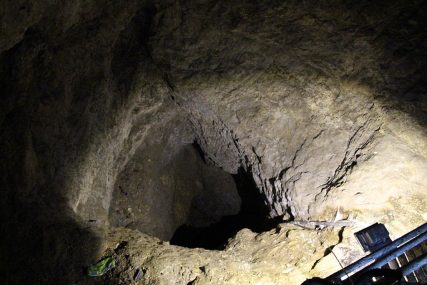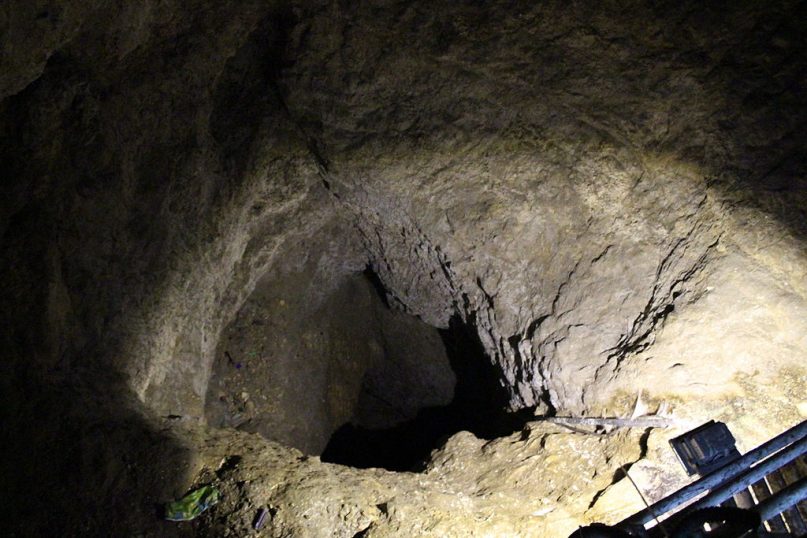
Warren’s Shaft, City of David, Jerusalem.
(RNS) It’s come at last — the end of “Dig,” the apocalyptic action series that concluded Thursday (May 7) on the USA Network.
The 10-part series by Tim Kring and Gideon Raff, two television hotshots with shows like “Heroes” and “Homeland” in their credits, consistently relied on religion and its zealots to fuel a complicated plot. Over and over, characters in the series warned of a coming Armageddon.
“If that mosque comes down, it will be World War III,” said Ian Margrove (Richard E. Grant), the evil archaeologist of “Dig.” “Armageddon. The end of everything.”
Maybe. Maybe not. But first, what is the origin and accuracy of the religious aspects of shall we say, the series’ rather storied plot?
Read on at your peril. Spoilers ahead.
Blood Moon
“There are prophesies that say, ‘beware the blood moon,’” a rabbi says as a huge, red moon hangs over Jerusalem, where much of “Dig” is filmed.
That is true. “The sun shall be turned to darkness, and the moon into blood, before the great and terrible day of the Lord comes,” reads Joel 2:31. A blood moon is mentioned again in Revelation, the book that lays out the end of the world and the Second Coming of Jesus.
A blood moon happens when a lunar eclipse causes the earth’s shadow to fall on the moon — giving it a rusty shade. We are in the midst of a string of four such moons, with the first on April 15, 2014.
End times-spinners and other writers have made hay with blood moons for a long time. The most recent example is the book “Four Blood Moons” by Christian pastor John Hagee. Hagee says the four lunar eclipses coincide with Jewish holidays and are a sign the end is near.
Hagee’s book topped best-seller lists, including The New York Times, Publishers Weekly and Amazon, and prompted several major astronomical organizations to respond to people’s questions about the blood moons and biblical prophecy.
Does the blood moon really portend the end? We’ll all find out on Sept. 28 this year — the last of the four blood moons Hagee is worried about.
Warren’s Shaft
There really is a Warren’s Shaft under the Dome of the Rock and it really was used for drawing water. It was discovered in 1867 by British engineer Sir Charles Warren.
- READ: “Dig’s depiction of the Dome of the Rock
There was a theory that the shaft was the underground tunnel used by King David’s army to capture Jerusalem, a story told in the biblical book of Samuel. Now, scholars believe the shaft is not man-made, but a natural fissure in the rock that was used for fresh water since the 18th century B.C.
So, when the series’ Emma (Alison Sudol) says to “follow the water,” she’s talking about something folks have been doing under and on Temple Mount for a lot longer than the folks at “Dig.” And how fitting that the world should be saved by diverting a flood through the Warren’s Shaft?
They are not my people anymore
Avram (Guy Selenik), the yeshiva boy who saves a baby cow named Red, gets the closing shot in the series. And he’s changed — gone is the black garb, prayer tassels and side curls that marked his character as a member of an ultra-Orthodox Jewish sect. Wearing a pair of Levis and tennis shoes, he says of them, “They are not my people anymore.”
Young men and women do leave ultra-Orthodox communities, and when they do, they lose everything — families, friends, homes, jobs.
Avram’s struggle with the world outside his sect has been an ongoing theme in “Dig.” He confronted disdainful sailors on the boat to Croatia and he struggled with sexual temptation while staying with a family of Christians.
The writers of “Dig” leave Avram in a kind of religious limbo — a place many who leave fundamentalist groups find themselves. Is he now secular? An atheist? Or does he perhaps still consider himself a religious Jew, just not quite so fundamentalist?
His adventures could fill a whole new season of “Dig.”
What does it mean?
“Dig” has been both lauded and condemned by critics. Most lamented its borrowing of plot elements from better known — and more widely consumed — pieces of pop culture like “Raiders of the Lost Ark” and “The Da Vinci Code.” But the creators of “Dig” delivered what they advertised — a fast-paced puzzle of a story that entertained. And they did it with a heavy dose of religious history, imagery and themes that — to their credit — were almost entirely based on fact.
YS/AMB END WINSTON





